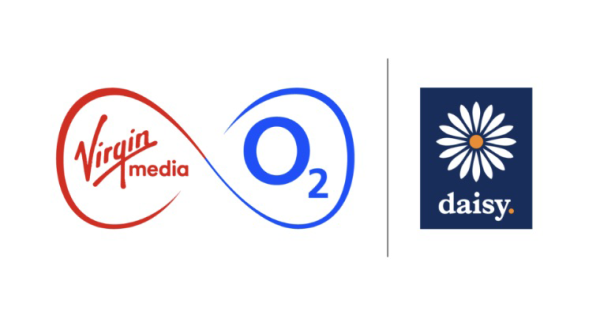Virgin Media O2 and Daisy Unite to Transform UK Business Connectivity
Virgin Media O2 has announced the formation of a new business-focused entity in partnership with Daisy Group, aimed at reshaping the UK enterprise telecoms and IT services landscape. The move combines the business-to-business (B2B) operations of both companies to create a single platform with scale, reach, and a comprehensive suite of digital solutions.
This new entity will focus solely on serving UK enterprises, from small businesses to large corporations and public sector organizations. Virgin Media O2 will hold a 70% stake, while Daisy Group will retain 30% ownership. The joint venture is set to generate approximately £1.4 billion in pro-forma revenue and £150 million in adjusted EBITDA based on 2024 results.
Merging Infrastructure and Managed Services for Complete Enterprise Solutions
The new B2B-focused company brings together Virgin Media O2’s strong connectivity infrastructure and Daisy Group’s expertise in managed services and IT. Both companies believe the alignment will create synergies by offering integrated solutions across cloud services, cybersecurity, IoT, AI-powered tools, and private 5G networks.
According to Virgin Media O2 CEO Lutz Schüler, the deal represents a shift from a consumer-heavy focus to a more balanced business growth strategy. “To carve this business out as a separate entity, fully focused on B2B is much better. It will get more sun and more rain,” he remarked in an interview.
Daisy Group founder and executive chairman Matthew Riley emphasized the potential to deliver “a comprehensive solution for the fast-changing needs of UK organizations,” leveraging Daisy’s unified communications platforms and advanced technology products.
Leadership Team and Setup of the New UK B2B Telecom Entity
The newly formed company will be chaired by Matthew Riley, while Jo Bertram, Managing Director of Virgin Media O2 Business, will step in as Chief Executive Officer. At launch, both brands will maintain separate identities and operate from their existing offices, allowing for a gradual transition while preserving customer trust and brand equity.
The merger is expected to close in the second half of 2025, subject to regulatory approvals. Additional leadership appointments and structural decisions will be made as integration advances.
Next-Gen B2B Services: Cloud, 5G, IoT, and AI for UK Enterprises
The combined business will act as a one-stop shop for enterprise customers, with an emphasis on digital transformation. Services will include:
- Private 5G Networks: Tailored wireless connectivity for industrial sites, logistics hubs, and corporate campuses.
- IoT Solutions: Managed services to support device connectivity, monitoring, and automation.
- AI-Enabled Services: Offerings like O2 Motion that analyze mobility data to enhance business decision-making.
- Cloud and Communications Tools: Including Microsoft-based platforms and hybrid cloud solutions.
- Security Services: End-to-end digital security for networks, data, and devices.
This integrated portfolio positions the new company to better compete with traditional telecoms, cloud-first providers, and enterprise-focused tech players.
Unlocking £600M in Synergies Through Integration and Efficiency
One of the major drivers behind the merger is operational efficiency. Virgin Media O2 projects that the new company will achieve £600 million in total synergies, translating to an annualized run rate of £70 million by 2030. These savings will stem from IT platform consolidation, organizational streamlining, and procurement optimizations.
Wholesale access agreements with Virgin Media O2 will continue to support the company’s mobile and fixed connectivity offerings. Additionally, the partnership benefits from supplier relationships with Telefonica and Liberty Global, allowing access to broader portfolios and innovations.
Merger Financing: Loan Structure, Debt Strategy, and Leverage Targets
The deal is structured as an all-share transaction. Virgin Media O2 will contribute a £425 million secured intercompany loan, while Daisy Group adds around £835 million in debt. Virgin Media O2 plans to raise additional financing at its cost of debt to support the refinancing of Daisy’s existing obligations.
Despite the size of the transaction, Virgin Media O2 expects minimal short-term impact on its leverage ratios. The company will maintain its current 4x–5x medium-term leverage target. Cash flow from the new entity will be used initially for deleveraging, aligning with Virgin Media O2’s broader financial strategy.
Exit provisions are in place to give both partners future flexibility, whether through buyouts or other strategic moves.
Meeting Enterprise Demand in a Digitally Transforming UK Economy
As digital transformation accelerates across all industries, demand for integrated telecom and IT services is on the rise. UK businesses are seeking solutions that go beyond simple connectivity—such as advanced analytics, AI-powered decision support, and end-to-end cloud architecture.
By pooling resources and expertise, Virgin Media O2 and Daisy Group are positioning themselves to meet this demand more effectively than either could alone. The B2B telecoms and managed services space is highly competitive, and this merger gives the combined entity both scale and specialization.
Furthermore, regulatory pressures and cybersecurity concerns are pushing enterprises to work with providers that can ensure compliance, reliability, and local accountability—another strength of the new joint venture.
Prioritizing Service and Support in the UK B2B Telecom Market
Beyond technology and infrastructure, the new company aims to differentiate through its customer experience. Both Virgin Media O2 and Daisy Group have emphasized the importance of a dedicated, service-oriented culture. Riley noted that “specialist teams” would bring a “relentless focus on customer service,” especially in navigating complex IT and telecom deployments.
By retaining the entrepreneurial mindset of Daisy and combining it with Virgin Media O2’s national scale, the leadership team hopes to drive strong organic growth, win new enterprise accounts, and cross-sell more services to existing customers.
Why This Merger Could Reshape UK Enterprise Telecom Services
The Virgin Media O2–Daisy Group merger marks a significant development in the UK’s B2B telecom and IT services landscape. With a diverse solution portfolio, deep technical capabilities, and a clear strategic vision, the new entity is poised to become a major force in supporting the country’s digital economy.
As the deal progresses through regulatory approvals and integration planning, the market will be watching closely. Success will depend not only on financial execution but also on delivering tangible value to customers across all sectors—from retail and healthcare to smart cities and manufacturing.







































